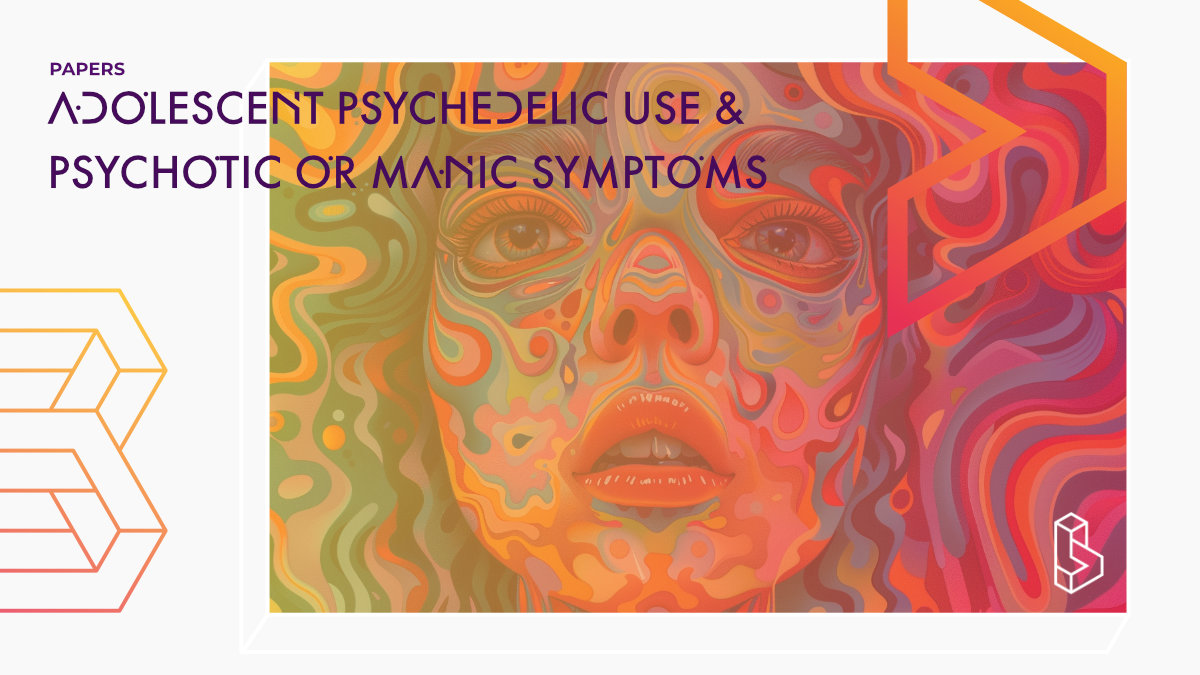This observational study (n=16.255) investigates the association between naturalistic psychedelic use and self-reported psychotic or manic symptoms in adolescents, utilizing a genetically informative design. Results suggest that psychedelic use may be associated with reduced psychotic symptoms after adjusting for other drug use, while associations with manic symptoms seem to be linked to genetic vulnerability to schizophrenia or bipolar I disorder.
Abstract of Adolescent Psychedelic Use and Psychotic or Manic Symptoms
“Importance: While psychedelic-assisted therapy has shown promise in the treatment of certain psychiatric disorders, little is known about the potential risk of psychotic or manic symptoms following naturalistic psychedelic use, especially among adolescents.
Objective: To investigate associations between naturalistic psychedelic use and self-reported psychotic or manic symptoms in adolescents using a genetically informative design.
Design, Setting, and Participants: This study included a large sample of adolescent twins (assessed at age 15, 18, and 24 years) born between July 1992 and December 2005 from the Swedish Twin Registry and cross-sectionally evaluated the associations between past psychedelic use and psychotic or manic symptoms at age 15 years. Individuals were included if they answered questions related to past use of psychedelics. Data were analyzed from October 2022 to November 2023.
Main Outcomes and Measures: Primary outcome measures were self-reported psychotic and manic symptoms at age 15 years. Lifetime use of psychedelics and other drugs was also assessed at the same time point.
Results: Among the 16 255 participants included in the analyses, 8889 were female and 7366 were male. Among them, 541 participants reported past use of psychedelics, most of whom (535 of 541 [99%]) also reported past use of other drugs (ie, cannabis, stimulants, sedatives, opioids, inhalants, or performance enhancers). When adjusting for substance-specific and substance-aggregated drug use, psychedelic use was associated with reduced psychotic symptoms in both linear regression analyses (β, −0.79; 95% CI, −1.18 to −0.41 and β, −0.39; 95% CI, −0.50 to −0.27, respectively) and co-twin control analyses (β, −0.89; 95% CI, −1.61 to −0.16 and β, −0.24; 95% CI, −0.48 to −0.01, respectively). In relation to manic symptoms, likewise adjusting for substance-specific and substance-aggregated drug use, statistically significant interactions were found between psychedelic use and genetic vulnerability to schizophrenia (β, 0.17; 95% CI, 0.01 to 0.32 and β, 0.17; 95% CI, 0.02 to 0.32, respectively) or bipolar I disorder (β, 0.20; 95% CI, 0.04 to 0.36 and β, 0.17; 95% CI, 0.01 to 0.33, respectively).
Conclusions and Relevance: The findings in this study suggest that, after adjusting for other drug use, naturalistic use of psychedelic may be associated with lower rates of psychotic symptoms among adolescents. At the same time, the association between psychedelic use and manic symptoms seems to be associated with genetic vulnerability to schizophrenia or bipolar I disorder. These findings should be considered in light of the study’s limitations and should therefore be interpreted with caution.”
Authors: Otto Simonsson, Miriam A. Mosing, Walter Osika, Fredrik Ullén, Henrik Larsson, Yi Lu & Laura W. Wesseldijk
Summary of Adolescent Psychedelic Use and Psychotic or Manic Symptoms
Recent evidence indicates that LSD and other 5HT2AR agonist psychedelics have increased among adolescents in the US. However, less is known about the risks associated with naturalistic use of psychedelics.
Guidelines recommend that individuals with a personal or family history of psychotic or bipolar disorders be excluded from participation in clinical trials of psychedelic-assisted therapy. However, this also limits the possibility of quantifying psychiatric risks.
Twin modeling studies have rarely been used in psychedelic research, but can be used to control for familial confounding and test whether the association between psychedelic use and psychotic or manic symptoms is in line with a causal hypothesis.
Find this paper
Adolescent Psychedelic Use and Psychotic or Manic Symptoms
https://doi.org/10.1001/jamapsychiatry.2024.0047
Open Access | Google Scholar | Backup | 🕊
Cite this paper (APA)
Simonsson, O., Mosing, M. A., Osika, W., Ullén, F., Larsson, H., Lu, Y., & Wesseldijk, L. W. (2024). Adolescent Psychedelic Use and Psychotic or Manic Symptoms. JAMA psychiatry.
Study details
Topics studied
Adolescence and Psychedelics
Schizophrenia
Study characteristics
Survey
Participants
16255
Humans

